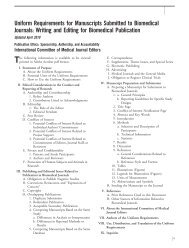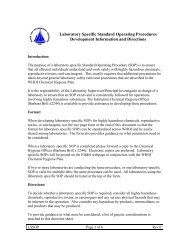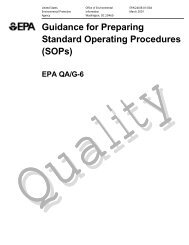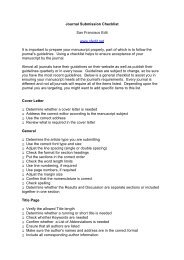Acrylamide in Baking Products: A Review Article
Acrylamide in Baking Products: A Review Article
Acrylamide in Baking Products: A Review Article
Create successful ePaper yourself
Turn your PDF publications into a flip-book with our unique Google optimized e-Paper software.
538 Food Bioprocess Technol (2011) 4:530–543<strong>in</strong>formation obta<strong>in</strong>ed from such experiments, bak<strong>in</strong>g conditionswere def<strong>in</strong>ed to achieve similar crust colour withvarious bak<strong>in</strong>g techniques. It was obvious that theacrylamide content <strong>in</strong> bread crust could be reduced us<strong>in</strong>galternative bak<strong>in</strong>g technologies. Reduced levels wereobta<strong>in</strong>ed with both <strong>in</strong>frared radiation and air jet imp<strong>in</strong>gementbak<strong>in</strong>g.Prelim<strong>in</strong>ary experiments were also performed to studythe flavour of breads baked by these new technologies. Aclose relationship was found to hold between the presenceof a large number of volatiles, especially those volatile andodorous compounds that are known to be formed viabrown<strong>in</strong>g reactions <strong>in</strong> the bread crust like Streckeraldehydes and alkyl pyraz<strong>in</strong>e, and the formation ofacrylamide for the bak<strong>in</strong>g methods studied. Obviously, thebak<strong>in</strong>g method that produced low amounts of acrylamide <strong>in</strong>these experiments also tended to result <strong>in</strong> low contents ofimportant flavour substances.IR bak<strong>in</strong>g has been further focussed on to evaluate howit can be optimized with regard to acrylamide m<strong>in</strong>imizationand sensory product quality. Crust colour, acrylamide,flavour compounds and sensory characteristics were <strong>in</strong>vestigatedas a function of bak<strong>in</strong>g time under various bak<strong>in</strong>gconditions. One important f<strong>in</strong>d<strong>in</strong>g from these experimentswas that, with IR bak<strong>in</strong>g, it is possible to obta<strong>in</strong> a sensoryprofile almost identical to that of conventionally bakedbread, but with considerably lower acrylamide content. Areduction of acrylamide content by 60% could be shown(HEATOX Project 2007).Effects of Precursors and Reaction ConditionsThe <strong>in</strong>fluence of the composition of food and thermalconditions of the process are the ma<strong>in</strong> factors that <strong>in</strong>teractwith acrylamide formation (Berg and Van Boekel 1994;Morales et al. 1997; Gökmen et al. 2007; Gökmen and Acar1999; Gökmen and Şenyuva 2006). S<strong>in</strong>ce reduction ofacrylamide content is a major concern of bak<strong>in</strong>g producers,Gökmen et al. (2007) studied the effects of dough formulaand bak<strong>in</strong>g conditions on acrylamide formation <strong>in</strong> cerealproducts (cookies) (Fig. 5). They <strong>in</strong>vestigated the type andconcentrations of sugars and pH levels along with theeffects of six different formulae and measured hydroxymethylfurfural(HMF) as a chemical <strong>in</strong>dicator and as anacrylamide precursor to assess the quality of thermallyprocessed food products. They reported that the amount ofsucrose <strong>in</strong> the recipe was less effective on the yield ofacrylamide than glucose because <strong>in</strong>creas<strong>in</strong>g amounts ofsucrose from 10 to 35 g <strong>in</strong> the recipe almost doubled theamount of acrylamide formed dur<strong>in</strong>g bak<strong>in</strong>g. This is whilereplac<strong>in</strong>g sucrose with glucose <strong>in</strong> the recipe resulted <strong>in</strong> adrastic <strong>in</strong>crease <strong>in</strong> the amount of acrylamide formationupon bak<strong>in</strong>g at 205 °C for 11 m<strong>in</strong> (74.1 ± 5.60 ng/g ofacrylamide <strong>in</strong> cookies). The reason for this, they claimed, isthat the hydrolysis of sucrose might be very limited underthese bak<strong>in</strong>g conditions (bak<strong>in</strong>g for 11 m<strong>in</strong> at 205 °C).Reduction of acrylamide formation by a factor of 50% ormore us<strong>in</strong>g sucrose <strong>in</strong>stead of reduc<strong>in</strong>g sugars (e.g.glucose) confirms earlier f<strong>in</strong>d<strong>in</strong>gs by other researchers(Amre<strong>in</strong> et al. 2004; Graf et al. 2006; Vass et al. 2004).Some authors have also reported that a reduc<strong>in</strong>g sugar isneeded to form acrylamide from asparag<strong>in</strong>e (Mottram et al.2002; Stadler et al. 2002; Yaylayan et al. 2003). Sugarseems to be the most important <strong>in</strong>gredient <strong>in</strong> the doughformula for acrylamide formation because the free asparag<strong>in</strong>eis relatively low <strong>in</strong> wheat flour (0.15–0.40 g/kg;Surdyk et al. 2004; Noti et al. 2003). Rather than sugar,organic acids added to bak<strong>in</strong>g powders as an acidic salt toreduce pH decrease the amount of acrylamide formeddur<strong>in</strong>g bak<strong>in</strong>g (Surdyk et al. 2004; Rydberg et al. 2003;Jung et al. 2003; Kita et al. 2005). However, when reduc<strong>in</strong>gsugars are used <strong>in</strong> place of sucrose, the reduced pH<strong>in</strong>creases the amount of acrylamide by 1.8 times <strong>in</strong> cookiesunder the same bak<strong>in</strong>g conditions. This is probably due tothe excessive hydrolysis of sucrose (Gökmen et al. 2007).F<strong>in</strong>ally, they showed that the k<strong>in</strong>etics of acrylamideformation significantly differed between the recipes compris<strong>in</strong>gsucrose (with a lower <strong>in</strong>itial rate of formation) andthose with glucose (with a rapidly <strong>in</strong>creas<strong>in</strong>g rate offormation). These results are comparable with thosereported by Summa et al. (2006) who confirmed a l<strong>in</strong>ear<strong>in</strong>crease <strong>in</strong> acrylamide concentration of cookies for therecipe compris<strong>in</strong>g glucose, but a lower <strong>in</strong>itial rate ofacrylamide formation with<strong>in</strong> a bak<strong>in</strong>g time of 15 m<strong>in</strong> withthe recipe us<strong>in</strong>g sucrose <strong>in</strong>stead of glucose.Even though acrylamide concentration <strong>in</strong>creases dur<strong>in</strong>gfry<strong>in</strong>g and bak<strong>in</strong>g, addition of different additives, such asrosemary, am<strong>in</strong>o acids or prote<strong>in</strong>, reduces the level ofacrylamide. Also, reduced pH dramatically reduces acrylamidecontent dur<strong>in</strong>g fry<strong>in</strong>g and bak<strong>in</strong>g (Tareke et al. 2002;Becalski et al. 2003; Brathen et al. 2005; Grob et al. 2003;Rydberg et al. 2003; Jung et al. 2003).It has been found that <strong>in</strong> bak<strong>in</strong>g products, addition ofasparag<strong>in</strong>e dramatically <strong>in</strong>creases the amount of acrylamide,but no effect of glucose addition is observed. However,the <strong>in</strong>crease <strong>in</strong> acrylamide content occurs only with lowerconcentrations of asparag<strong>in</strong>e, whilst at higher concentrations,a decrease is observed <strong>in</strong> acrylamide content. This<strong>in</strong>dicates that one acrylamide elim<strong>in</strong>ation mechanism mightbe its reaction with excess amounts of am<strong>in</strong>o acids.Rydberg et al. (2003) reported that addition of am<strong>in</strong>o acidsor prote<strong>in</strong>-rich <strong>in</strong>gredients reduced the amount of acrylamide.No similar decrease at high concentrations was foundfor glucose, <strong>in</strong>dicat<strong>in</strong>g that reaction of acrylamide withcarbohydrates is <strong>in</strong>significant <strong>in</strong> the removal of acrylamide(Brathen et al. 2005).







